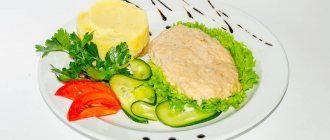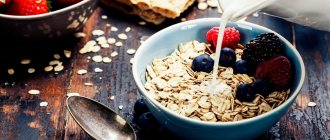Full text of the article:
With intestinal diseases, it is especially important to pay attention to nutrition. Intestinal diseases often cause a deficiency of nutrients in the body, as they disrupt the gastrointestinal tract and interfere with the absorption of nutrients. In addition to proteins and fats, the body may not receive enough vitamins and microelements that are necessary for normal functioning, so it is important to take care to avoid deficiencies. Proper nutrition helps with this.
What should be the diet for gastrointestinal diseases?
The diet for intestinal diseases should not be meager; on the contrary, it will be necessary to include sufficiently high-calorie foods in the diet. If a person’s food absorption process is disrupted, then he usually begins to quickly lose weight, not only fat, but also muscle tissue “melts”. This process must be balanced by increasing the amount of complete protein entering the body (at least 130-140 g).
It is recommended to switch to fractional meals
and eat small meals 5-6 times a day to reduce stress on the intestines. Food will enter the body more evenly, and the body will be able to absorb more nutrients.
Why is the balance of microflora disturbed?
This balance is very fragile and is easily subject to external influence. And this happens for several reasons:
- taking antibiotics
- eating disorder
- sugar and alcohol abuse
- poisoning
- taking certain hormonal medications
- diseases of the digestive system
- stress
- taking certain medications - non-steroidal anti-inflammatory drugs.
Signs of microflora disturbance
- Abnormal bowel movements - constipation, diarrhea, irregular bowel movements, bloating, colic, pain
- Disorders of the gastrointestinal tract - the appearance of heaviness, heartburn, belching, weight gain.
- Dehydration - the appearance of brittle and dry hair, nails, skin,
- Intoxication of the body - nausea, painful complexion, pimples and acne.
- The presence of an unpleasant odor when breathing, an unpleasant odor of feces
- Changes in the nervous system - fatigue, drowsiness, lack of mood, decreased performance.
- Dizziness and headaches
Mineral deficiency
In case of intestinal diseases, the body receives insufficient minerals, but this deficiency can be replenished with the help of dairy products
. Not only do they contain a lot of minerals, but they are also easily absorbed by the body. Dairy products can provide the body with a sufficient amount of phosphorus and calcium, but one must keep in mind that not all dairy products can be well tolerated by the body in case of intestinal diseases. For example, fresh milk may be too “heavy”, and fermented milk products, due to their increased acidity, can irritate the walls of the stomach.
The most neutral and useful product for intestinal diseases is unleavened cottage cheese.
, as well as unsalted and low-fat
cheese
. These products can be an alternative to kefir and yogurt. It is only important that the products are fresh and natural, without additional spices or flavor enhancers.
Bonus: Can Microbes Control Human Behavior?
This hypothesis is now becoming very popular and, indeed, has a number of direct and indirect reasons. The intestine is called the second brain of a person and the bacteria living in it are truly capable of controlling a person at the level of the nervous system.
At the moment, humanity knows a lot about our body, but not everything. Research in the field of intestinal microflora and its effect on the health and quality of the body is in its infancy, but is attracting more and more attention from the scientific world. Thus, in the course of studying the human microbiome, the existence of a strong relationship between the state of bacteria and the functioning of the immune, nervous and endocrine systems was confirmed. Some scientists believe that bacteria may release certain signaling molecules that influence the activity of the decimal cranial nerve, which runs from the gut to the brain, or the vagus nerve may be involved in this process.
It is impossible to say how long it will take to fully understand a person, but you can be sure that we have come to extremely important discoveries that, in the future, will solve many health problems, help find the key to incurable diseases and completely change everyday life. Be healthy!
Products that regulate bowel function
Various intestinal diseases can be accompanied by different and sometimes even opposite symptoms. For example, a person may suffer from diarrhea or, conversely, suffer from constipation. You can improve intestinal function with the help of certain diets and eating foods that have a laxative effect or weaken intestinal function.
To natural “ laxatives”
” include dried fruits, kefir, legumes, oatmeal and buckwheat.
They are recommended for use by people suffering from periodic constipation, even if it is not caused by intestinal diseases.
Mashed porridges, slimy soups, and foods high in tannin help the stomach work
How intestinal microflora helps you lose weight
Another focus of attention of scientists and researchers is the dependence of a person’s weight on the diversity of microflora. Thus, recent research by American scientists has confirmed this fact. In the experiment, sets of gut bacteria from human twins were placed into the intestines of germ-free mice. In one set the twins were thin, in the other they were obese. Microbes taken from thin twins caused weight loss in mice, and bacteria from overweight twins caused obesity in mice. But after a while, when the mice were put in the same cage, the obese mice began to rapidly lose weight.
Scientists have made the assumption that microflora
is able to control eating habits, requiring a person to provide certain foods that will promote the growth of either pathogenic or “lean” bacteria. The best diet for some bacteria is fat and they constantly require it again and again, while others need sugar. It is on the dependence of nutritional needs and the diversity of bacteria in the intestines that scientists have put forward the theory that intestinal settlers seek to take over humans and manipulate the chemical composition of the environment for their own purposes and benefit. This, in turn, may mean manipulating our behavior (we get nervous if we don’t eat sweets) by influencing hunger centers with the help of nerve impulses, the desire to eat this or that product, for certain foods, or a feeling of disgust from certain foods .
Diet No. 4 for intestinal diseases
People who suffer from intestinal diseases have probably heard or even experienced “ diet number 4.”
" This is a special diet that was developed for the treatment and prevention of intestinal diseases. “Diet No. 4” has several more variations, which are indicated by letters. They are based on the same “diet No. 4”, but with certain relaxations; adjustments are made for the severity of the disease and the stage of its cure.
“Diet No. 4” itself is the most gentle for the digestive tract, and therefore the most strict. It provides a diet low in fat and carbohydrates. The diet should not contain fried, smoked, salted or other hot or spicy foods. Only food that has been steamed or boiled and then pureed is allowed.
A common variation of “diet No. 4” is “ diet No. 4c”
” is prescribed to people who have already suffered an acute stage of intestinal disease and are gradually returning to their usual nutritious diet. “Diet No. 4b” helps to restore weight lost due to illness and involves split meals.
How to restore intestinal microflora
The process of microflora restoration is not fast. It is important not only to adjust the diet, but also to actively help the body “build up” the microbiome - to choose the right drug containing pre- and probiotics.
Linex Probiologist Probifid RioFlora Immuno
Hilak Forte
Duphalac
Maxilac
Lactobalance
Bion-3
Diet No. 4c: do's and don'ts
Diet No. 4c is not as strict as Diet No. 4. It is believed that a person has already suffered from the disease and is ready to return to normal life, but must do this gradually to prevent additional stress on the body. You can eat different food groups, but stick to restrictions.
You can eat dry
biscuits and cookies, day-old bread, but avoid rich and sweet pastries and pies. You can eat soups with vegetable broth, lean meat and fish, baked, boiled or steamed, but you should avoid sausages and anything fried. The same applies to egg dishes: the diet may include steamed omelettes and protein dishes, but there should be no raw, hard-boiled or scrambled eggs. It is permissible to eat crumbly porridges made from tender cereals and small pasta, as well as boiled vegetables, but they must be cooked in water or with a minimum amount of oil.
Prohibited
dairy and sweet cereals, raw vegetables, large types of pasta, some coarse cereals, fruits and berries with high acidity, whole milk and fermented milk products, sweet carbonated drinks, strong tea, coffee and alcohol, vegetable and vegetable oil. You can replace all these products with more “gentle” analogues: bake apples for sweets or choose fruits with a delicate texture, consume milk only as additives to other dishes, replace fermented milk products with non-acidic cottage cheese or curd paste, drink weak tea or rosehip decoction, you can allow Add a little natural butter to your dishes.
Here are 10 healthy foods that are richest in coarse plant fibers.
1. Whole grain bread. One of the most accessible sources of fiber, microelements and vitamins is wholemeal bread. Rye bread is considered to be the healthiest: it is low in calories and contains a lot of dietary fiber, which lowers blood sugar and cleanses the digestive tract. By the way, rye bread is often included in therapeutic diets, as 2-3 pieces a day help normalize digestion.
2. Bran and grains. A plate of cereal with pieces of fruit for breakfast provides almost 14 grams of fiber in its pure form. For example, a bowl of oatmeal covers a quarter of a person’s daily requirement for fiber, and the starch contained in oats is slowly digested and absorbed, providing a feeling of fullness for a long time.
3. Lentils and other legumes. One cup of cooked lentils contains about 16 grams of fiber. Moreover, it is a unique source of iron and zinc, and also does not accumulate toxins, and therefore is considered an environmentally friendly product. Other legumes are also rich in dietary fiber. A cup of black beans contains about 15 grams of fiber, and a cup of kidney beans contains 13 grams. In general, all legumes are a healthy addition to the diet. But they need to be added to the diet gradually in order to avoid increased gas formation and bloating.
4. Berries: raspberries, strawberries, blueberries, gooseberries. Most berries are very high in fiber. One cup of raspberries, which are virtually intact when processed, contains 8 grams of fiber and only 60 calories.
5. Avocado. Avocados are high in fiber: one medium fruit contains about 12 g of healthy fiber. This fruit can improve the composition of intestinal microflora, enhance peristalsis and is a preventative against constipation.
6. Almonds, pistachios and other nuts. Quite high in calories (1 ounce serving contains 161 calories), almonds are high in nutrients: nearly 13 grams of unsaturated fat and 3.4 grams of fiber—about 14% of your daily recommended intake. Pistachios have fewer calories, but they also have enough benefits. American scientists have found that to increase the elasticity of arteries and lower cholesterol levels by 8.5%, it is enough to eat 70-80 grams of pistachios a day. By the way, they can be consumed separately or added to porridge, yogurt, baked goods or sauces.
7. Pears are also rich in healthy fiber: a medium-sized fruit contains up to 5 g of fiber. This fruit contains more fructose than glucose (as you know, fructose does not require insulin for its absorption in the body), and therefore is considered useful for impaired pancreatic function.
8. Flaxseeds contain both types of fiber - soluble and insoluble, and provide 2.8 grams of fiber per tablespoon. Flaxseed oil is often used as a laxative, and flax products reduce blood cholesterol levels. When used internally, the gastrointestinal tract is enveloped in the mucus they secrete, which is beneficial for ulcers, gastritis and other inflammatory processes. The high mucus content in flaxseed protects the inflamed mucous membrane of the esophagus and gastrointestinal tract from irritation and reduces the absorption of toxins. Flax seeds facilitate the elimination of undigested food debris, which has a positive effect on constipation and obesity.
9. Dried fruits: raisins, prunes. Prunes have a beneficial effect on intestinal function, and one of the reasons for this is their high fiber content (3.8 g per half cup). Other dried fruits are also rich in fiber. To improve digestion, it is recommended to add figs, dates, raisins, apricots or other dried fruits to your diet as a snack between meals. However, it should be remembered that dried fruits are very high in calories, and you should not eat them in large quantities.
10. Green vegetables. Green leafy vegetables are an excellent source of iron, beta-carotene and insoluble fiber. One cup of spinach, turnip leaves or beets contains 4 to 5 grams of fiber. Also among the leaders in fiber content among vegetables are cauliflower, green bell peppers, broccoli, radishes, black radish, savoy cabbage, beets, cucumbers, carrots, celery, asparagus, kohlrabi, zucchini.
Photo: wavebreakmedia / freepik.com










